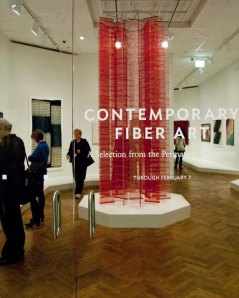 It was the well worth the wait. The first museum retrospective of Sheila Hicks‘ remarkable career has opened at the Addison Gallery and will travel to additional venues in the next few years, including the Institute of Contemporary Art of Philadelphia next March 2011 and the Mint Museum of Craft + Design, Charlotte, NC in October 2011.
It was the well worth the wait. The first museum retrospective of Sheila Hicks‘ remarkable career has opened at the Addison Gallery and will travel to additional venues in the next few years, including the Institute of Contemporary Art of Philadelphia next March 2011 and the Mint Museum of Craft + Design, Charlotte, NC in October 2011.
The Addison is an ideal showcase for the expansive exhibition, which includes more than 100 works, journals, videos and photographs. The classic architecture of the gallery provides an ideal counterpoint for Hicks’ brilliantly colored soft sculptures, for the more formal panels of stitched medallions and linen pony tails and for the minimes, framed miniature works, from various decades that are featured throughout the exhibition. When we arrived at sundown, the building was bathed in golden light an inviting complement to La Mémoire, the brilliantly colored series of wrapped cords to the left of the entrance and Bamian, the larger jewel-toned installation that can be seen in the distance in the gallery down the corridor.
The exhibition is comprehensive, addressing the remarkable reach of Hicks’ artistic life, which has included learning sewing and embroidery as a child in Nebraska, studying painting with Josef Albers at Yale, weaving in South America on a Fulbright and site commissions for public spaces including the Ford Foundation and Georg Jensen in New York, the Target corporate headquarters in Minneapolis, the Fuji City Cultural Center in Japan and the Banco de Mexico headquarters, with architect Ricardo Legorreta. In addition, Hicks has also published a magazine, created designs for commercial production, taught, founded workshops in Mexico, Chile, and South Africa, worked in Morocco and India, pursued interior and exterior architecture, sculpture, photography, book design and writing. To unravel this extraordinary range, the exhibition focuses on five related fields of inquiry: miniature weavings and drawings, site commissions for public spaces, industrially produced textiles and workshop hand-productions, bas reliefs and sculptures, and process works made of recuperated textiles, clothing and other found objects.

View from the top of the stairs: Sheila Hicks exhibition at the Addison Gallery. Photo by Carter Grotta
Regardless of the period, the works in the exhibit are strikingly original. We found ourselves constantly checking dates as 40-year-old works appeared as fresh as those made last year. The conclusion, after viewing Sheila Hicks; 50 Years, is inescapable: Hicks has reinvented textile tradition, and, in the process, transformed the terrain that links art, design and architecture.
The exhibition is at the Addison through February 27, 2011 Addison Gallery of Art, Philips Academy, 80 Main Street, Andover, Massachusetts, 01810; 978 749 4000; http://www.andover.edu/Museums/Addison/Exhibitions/
OnViewNow/hicks/Pages/default.aspx
. We hope to see it in a least one of the venues that follows. Hicks work has always been about inhabiting space; we’d like to see this exhibition reconfigured.
 The exquisitely designed and lavishly illustrated accompanying volume from Yale Press, Sheila Hicks: 50 Years, by Joan Simon and Addison Curator, Susan C. Faxon, with an essay by Whitney Chadwick, documents the full extent of Hicks’ work, from exquisite miniature weavings to major sculptural pieces to such large-scale commissions as The Four Seasons of Fuji. It is available from browngrotta.com.
The exquisitely designed and lavishly illustrated accompanying volume from Yale Press, Sheila Hicks: 50 Years, by Joan Simon and Addison Curator, Susan C. Faxon, with an essay by Whitney Chadwick, documents the full extent of Hicks’ work, from exquisite miniature weavings to major sculptural pieces to such large-scale commissions as The Four Seasons of Fuji. It is available from browngrotta.com.







